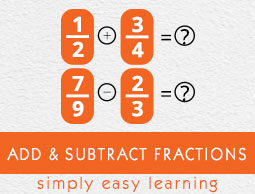
- Add and Subtract Fractions
- Home
- Add or Subtract Fractions With the Same Denominator
- Add or Subtract Fractions With the Same Denominator and Simplification
- Finding the LCD of Two Fractions
- Addition or Subtraction of Unit Fractions
- Addition or Subtraction of Fractions With Different Denominators
- Add or Subtract Fractions With Different Denominators Advanced
- Word Problem Involving Add or Subtract Fractions With Different Denominators
- Fractional Part of a Circle
Add or Subtract Fractions With Different Denominators: Advanced
Introduction
When we have addition or subtraction of fractions with unlike denominators, we first find the Least Common Denominator (LCD) of the fractions. We then rewrite all fractions as equivalent fractions with LCD as the denominator. Now that all denominators are alike, we add or subtract the numerators and put the result over the common denominator to get the answer. If necessary, we express the fraction in lowest terms.
Problem 1
Add $\frac{3}{5}$ + $\frac{3}{8}$
Solution
Step 1:
Add $\frac{3}{5}$ + $\frac{3}{8}$
Here the denominators are different. The LCD is 40 (product of 5 and 8) as 5 and 8 are co-prime numbers.
Step 2:
Rewriting
$\frac{3}{5}$ + $\frac{3}{8}$ = $\frac{(3×8)}{(5×8)}$ + $\frac{(5×5)}{(8×5)}$ = $\frac{24}{40}$ + $\frac{25}{40}$
As the denominators have become equal
$\frac{24}{40}$ + $\frac{25}{40}$ = $\frac{(24+25)}{40}$ = $\frac{49}{40}$
Step 3:
So, $\frac{3}{5}$ + $\frac{3}{8}$ = $\frac{49}{40}$
Problem 2
Subtract $\frac{5}{8}$ − $\frac{7}{12}$
Solution
Step 1:
$\frac{5}{8}$ − $\frac{7}{12}$
Here the denominators are different. The LCD here is 24.
Step 2:
Rewriting
$\frac{5}{8}$ − $\frac{7}{12}$ = $\frac{(5×3)}{(8×3)}$ − $\frac{(7×2)}{(12×2)}$ = $\frac{15}{24}$ − $\frac{14}{24}$
As the denominators have become equal
$\frac{15}{24}$ $\frac{14}{24}$ = $\frac{(15−14)}{24}$ = $\frac{1}{24}$
Step 3:
So, $\frac{5}{8}$ − $\frac{7}{12}$ = $\frac{1}{24}$